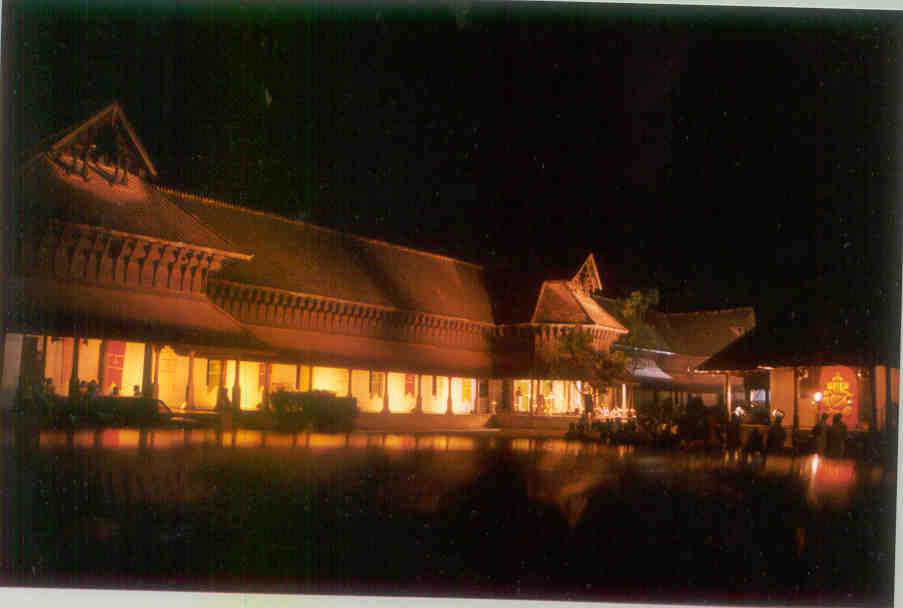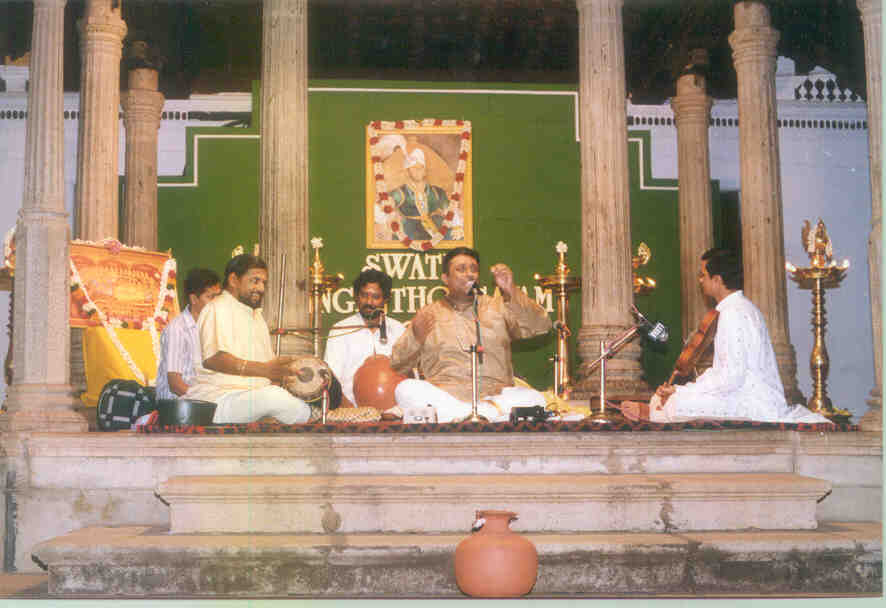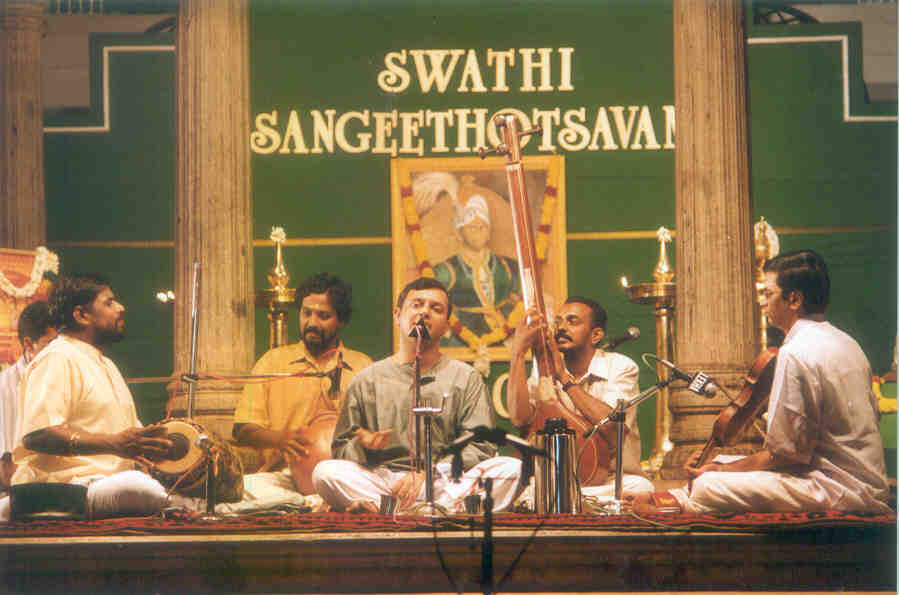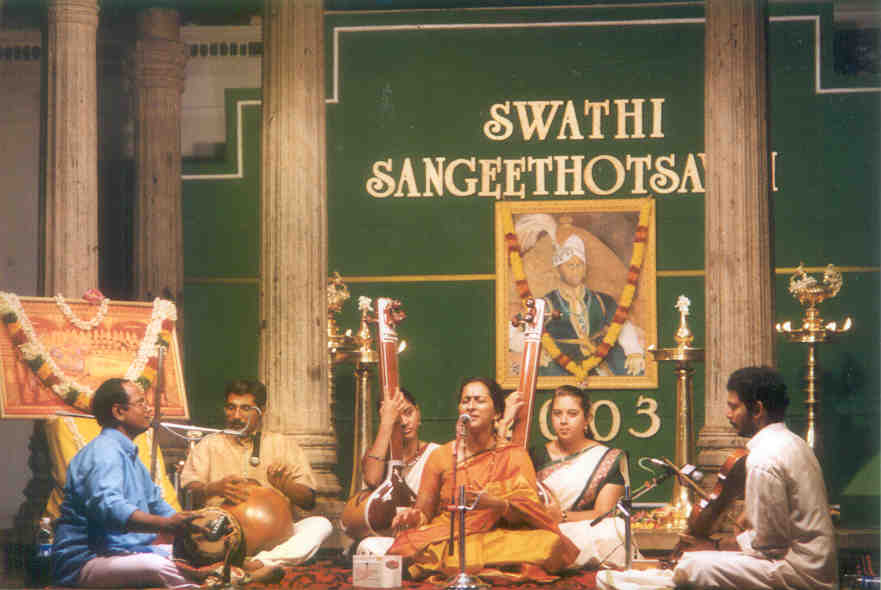|
Kripaya palaya shaurey
(Charukesi) followed, with the words falling out like a stream of pearls
from the mouth of the singer. Each time I hear Prince Rama Varma I
am stunned at the improvement in his voice tone and in the clarity of
pronunciation, perhaps as a result of his close association with Dr.
Balamuralikrishna. This was true in his diction during his
charmingly personal and extremely complementary introductions of the
other artists during all the other days of the festival too. Things
proceeded languidly into the most expansive and relaxed Gangeya Vasana
Dhara Padmanabha (Hamirkalyani) I have ever had the good fortune to
hear. By this time the four artistes on stage had fused into a single
moving spirit and the result was pure bliss. The singer, the composer, the
raga, the song, the audience, the surroundings and God, all fused into a
perfectly harmonious and etherial whole. And the percussion duo (the word
percussion itself seems altogether too harsh to describe what the two
artistes did that day) continued the spirit of the singer and the song in
an equally tranquil and harmonious manner. Balu Raghuraman's Hamirkalyani
was also particularly noteworthy this evening. The concert concluded with
a Bhajan Japata Japata Hari Nama in Ragamalika.
The third day witnessed one of
the most outstanding concerts of the series by Ranjani and Gayatri, who
opened with a Varnam in Kamas (Chalamela). They briskly went on to sing
Paramananda Natanam making one long for M D Ramanathan in his
prime. The swara singing that followed was crisp, and full of the unique
flavour of Kedaram. The violinist of the day H N Bhaskar, though
undoubtedly competent, seemed to flounder much of the time in Kedaram.
Surprise after surprise followed. Palayamaam in Nayaki, Parvati
Nayaka in Bowli and Pahi Sada in Mukhari, all rare and precious
gems. The already upbeat concert broke all the speed limits with a
super-fast Amritavarshini which left the listeners breathless. At the end
of it, one of the young ladies made the slightest musical slip, which
seemed to affect her obviously perfectionist nature to the very core. And
for the next fifteen to twenty minutes, every single sensitive parent in
the audience must have longed to pat her on the cheek and ask her to
forget it, cheer up and move on, because she was so obviously brilliant in
any case. These two violinist-turned-singers display a playfulness and
fragility almost like that of two newborn kittens tumbling around happily.
But the grip of their voices on each note is like steel, rendering even
the super-fast phrases too unusually clear and pleasing to the ear.
Bhogindra Shayinam, which was one of the few songs repeated during
the course of the whole series, appeared and disappeared in a flash. Then
came the real feast of the evening, a magnificent Sankarabharanam shared
fairly by the twosome followed by the ever so grand yet almost unheard of
Kalaye Parvati Natham which transformed the whole atmosphere
into one of utmost dignity and grandeur. The Tani Avartanam was by Manoj
Siva, (a practitioner of the Palghat Raghu style of Mridangam playing, who
was obviously on home ground in Misra Chapu Tala) and Haripad Sekhar. The
latter was competent enough but seemed to have a slight problem with the
sruti. The tukkadas which followed (Bhaja Bhaja Manasa,
Smara Janaka Subha Charita, Kantanodu Chennu Melle and
Sankar Giri Nath Prabhu ke) were each a treat. I found Smara
Janaka and Sankar Girinath particularly brilliant, with the
perfect dash of North Indian touch, which made things authentic without
making them sound like a mimicry of Hindustani music.
On the fourth day, the stage was filled to
capacity with veterans Parur M S Anantaraman, M A Sundareswaran and M A
Krishnaswami, accompanied by Prof. Trichy Sankaran (a rare treat for those
of us in Kerala who don't get a chance to go to Madras for the Music
Season in December) from Toronto and Udipi Sridhar. M S Anantaraman made a
touching speech at the beginning of the concert informing the crowd how
the Parur family owed everything to the Travancore royal family, and how
his father, the legendary Parur Sundaram Iyer used to eat at the Oottupura
of the Padmanabhaswami temple some eight decades ago. A rare and noble
gesture from this great vidwan indeed! The concert began briskly with the
Kambhoji Ata tala Varnam with Anantaraman generously and vocally
encouraging all the other artists on stage, particularly Prof. Trichy
Sankaran. This was followed by the sweetest little alapana in
Mayamalavagowla by Anantaraman himself, showing the finesse of his
technique and the freshness and originality of his spirit. The quality of
his touch evoked images of butterfly wings and angel kisses. Deva Deva
Kalayami followed predictably. Then came a dignified and sober
Srikumara nagaralaye (Atana), and Kripaya palaya
(Charukesi). Kalayami in Begada, a masterpiece popularised by GNB,
came as a welcome surprise, with M A Krishnaswami taking over now. This
was followed by a Kamavardhini alapana where M A Sundareswaran suddenly
seemed to have become possessed by some slightly malignant spirit. I was
surprised to see the normally chaste and sedate Sundareswaran almost saw
his instrument in half with enthusiasm. Sarasaksha Paripalaya was
subjected to more of the same treatment, followed by a brisk session of
swaras in the trade mark Parur style. The main piece of the evening was
the Navaratri kriti in Sankarabharanam Devi Jagath Janani, which
was rendered with commendable flair by the trio. This was followed by a
scintillating Tani Avartanam by the percussion duo, Sankaran and Sridhar.
The concert wound up with Mamava Sada Janani (which I have never
heard placed at the end of the concert till now), Visweswar in
Sindhubhairavi and the Dhanasri Tillana.
While the South Indian musicians
keep changing every year, the Asthana Vidwan from the North, Pandit Ajoy
Chakraborty, makes more than welcome visits year after year. This time, we
were treated to a soulful, expansive and mesmerising Jog, followed by a
composition by the Maharaja. He followed up with a composition in Behag
and Bhopali (the latter being a request from a member of the audience),
where he did a brisk and breathtaking ragamala by changing the Shadjam
from Sa to Ri, Ga, Pa and Dha and getting Megh Malhar, Malkauns, Durga and
Dhani respectively. This was followed by a leisurely Thumri (Miliye
Sham) in Khamaj and Bhajath Murali Murari in Kappar Gowri. The
final piece was Ramachandra Prabhu in Sindhubhairavi which never
fails to impress in Panditji's unique sophisticated style. The
accompanists were capable, but not brilliant (Yogesh Samsi on the Tabla
and Sanatan Goswami on the Harmonium). |
|
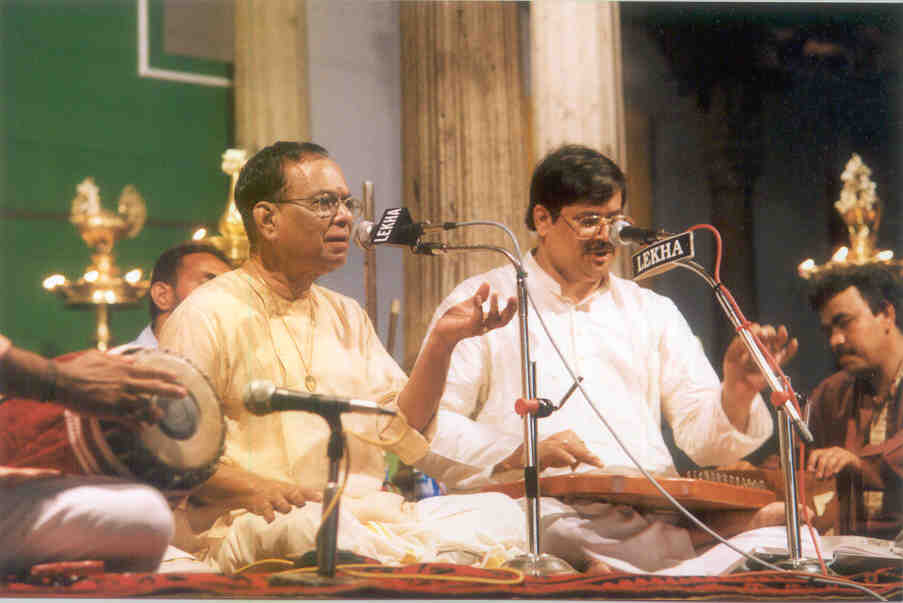
|
The most eagerly awaited concert
of the series was the Jugalbandi by doyens Dr. M Balamuralikrishna and
Pandit Ajoy Chakraborty. Dr. Balamuralikrishna made a speech at the
beginning pointing out that they were highlighting the similarities
between North Indian and South Indian classical music and not the
differences. The words were followed by the deed itself in the form of
three hours of bliss, mutual respect between the artistes, breathtaking
voice control, subdued and subtle competition, the finest aesthetics and
all-round magic. The duo started out with Pannagasayana in
Hamsadhwani, followed by Sarasiruhanabha in Deshakshi, where the
violinist of the evening young Attukal Balasubramaniam from
Tiruvanantapuram stole the show with his perfect little alapana which
echoed the very essence of what the two musicians had sung. The main piece
of the evening was Rama in Hamsanandi/Sohini. The very heavens must
have reverberated with the thundering voices of the twain that blessed us
with their magic. The Tani avartanam was a one-sided affair, with Dr. G
Babu playing with his heart and soul on the Mridangam and Badamikar
looking rather lost altogether. Then came two Balamurali vintage
favorites, Jamuna Kinare Pyare and Aaj Aye Sham Mohan. Not a
single person moved when the concert ended, although it was well over
three hours by then! Finally, Dr. Balamuralikrishna had to dispatch the
spellbound audience to their homes with a brief and conclusive "Thank
you!" |
